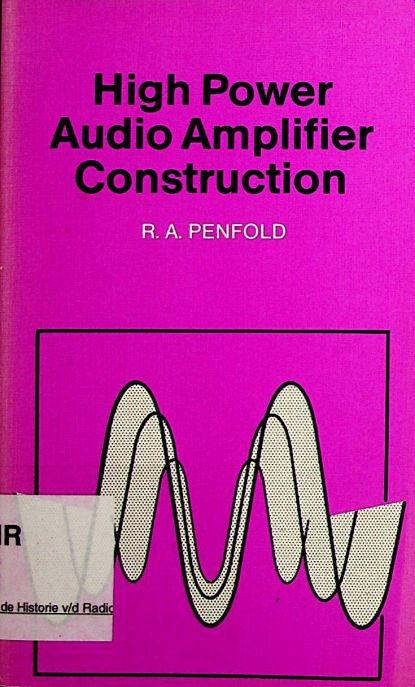High Power Audio Amplifier Construction
by R. A. Penfold

CONTENTS
Section 1: HIGH POWER PROBLEMS
- Warnings
- Loudspeaker Matching
- Lower Load Impedance
- Bridge Circuit
- Power Calculations
Section 2: BIPOLAR or MOSFET
- Class B
- Cross-over Distortion
- Thermal Runaway
- Power MOSFETs
- Parallel Operation
- Speed
Section 3: HIGH POWER CIRCUITS
- Configuration
- Practical Circuit
- Output Power
- Power Supply
- Construction
- Heatsink
- Insulation
- Supply Construction
- Setting Up
- Op Amp Techniques
- Op Power Amp
- Bridge Circuit
- Bipolar Amplifiers
- Thermal Stability
Semiconductor Pinout Details
Please Note:
Although every care has been taken with the production of this guide to ensure that any projects, designs, modifications and/or programs etc. contained herewith, operate in a correct and safe manner and also that any components specified are normally available in Great Britain, the Publishers do not accept responsibility in any way for the failure, including fault in design, of any project, design, modification or program to work correctly or to cause damage to any other equipment that it may be connected to or used in conjunction with, or in respect of any other damage or injury that may be so caused, nor do the Publishers accept responsibility in any way for the failure to obtain specified components.
Notice is also given that if equipment that is still under warranty is modified in any way or used or connected with home-built equipment then that warranty may be void.
©1991 BERNARD BABANI (publishing) LTD. First Published - April 1991
Preface
For most domestic purposes, amplifiers having output powers of about 50 watts r.m.s. per channel or less are perfectly adequate. However, there are some applications, particularly P.A. (public address) applications, that require substantially higher output powers. Really high output powers of about 500 watts r.m.s. or more are difficult to achieve using standard "off the shelf components from ordinary electronic component retailers. The same is not true for output powers of around 400 watts r.m.s. or less, which can now be achieved without having to resort to any exotic and difficult (or impossible) to obtain components. Output powers of this order are adequate for most purposes, and higher powers can effectively be achieved by using multiple loudspeaker arrays with a separate power amplifier driving each loudspeaker.
This guide provides relatively simple designs which offer good performance and maximum output powers of around 50 to 400 watts r.m.s. Note that these are true continuous r.m.s.
figures per amplifier, and are not some form of "total music power" or other rather misleading form of power rating. These amplifiers will provide high output powers indefinitely, and not just for a few output cycles at a fairly high frequency, or on single pulses! This point should be borne in mind when comparing the power ratings of these designs with those of other amplifiers.
Background information and some theory is provided in the first two Sections. The third Section provides some practical circuits for amplifiers using power MOSFETs and high power bipolar transistors in the output stages. Suitable mains power supply circuits are included. Printed circuit board designs are provided for the power MOSFET amplifiers, and wiring diagrams for the power supplies are included. Constructing these units is not particularly difficult, and is a task which is probably not beyond the capabilities of anyone with a certain amount of experience at electronic project construction.
However, as high power audio circuits inevitably involve the use of quite high supply voltages and currents, I could not recommend these projects for anyone with limited experience of project construction. Minor errors could cause a lot of costly damage, and could even be dangerous. No constructional information is provided for the amplifiers based on bipolar output transistors. These are really only included for those with considerable electronics experience - the power MOSFET designs offer much easier alternatives for those of more limited experience.
By R. A. Penfold
Please note overleaf is a list of other titles that are available in our range of Radio, Electronics and Computer Books.
These should be available from all good Booksellers, Radio Component Dealers and Mail Order Companies.
However, should you experience difficulty in obtaining any title in your area, then please write directly to the Publisher enclosing payment to cover the cost of the book plus adequate postage.
If you would like a complete catalogue of our entire range of Radio, Electronics and Computer Books then please send a Stamped Addressed Envelope to:
BERNARD BABANI (publishing) LTD THE GRAMPIANS SHEPHERDS BUSH ROAD LONDON W6 7NF ENGLAND
High Power Audio Amplifier Construction
-- This guide provides background information on high power audio amplifiers, together with some practical designs capable of output powers of up to around 300 to 400 watts r.m.s.
-- The high power amplifier designs include types having power MOSFETS in the output stage. These give excellent performance over the full audio range, and offer good reliability from what are relatively simple circuits. Printed circuit designs are included for these power MOSFET circuits, as are suitable mains power supply designs.
--- Using one of these power MOSFET amplifiers it is possible to obtain output powers of up to about 50 to 200 watts r.m.s., depending on the load impedance and the number of output devices used. By using two amplifiers (one inverting circuit and one non-inverting type) a bridge amplifier is produced, enabling very high output powers to be achieved (300 to400watts r.m.s. into a standard 8 ohm impedance load) For those who prefer to use bipolar output transistors, inverting and non-inverting circuits are provided. These can be used in single-ended or bridge configurations, and provide comparable output powers to the power MOSFETs.
Also see:
Installing Hi-Fi Systems (1960)
Understanding Hi-Fi Circuits (1957)